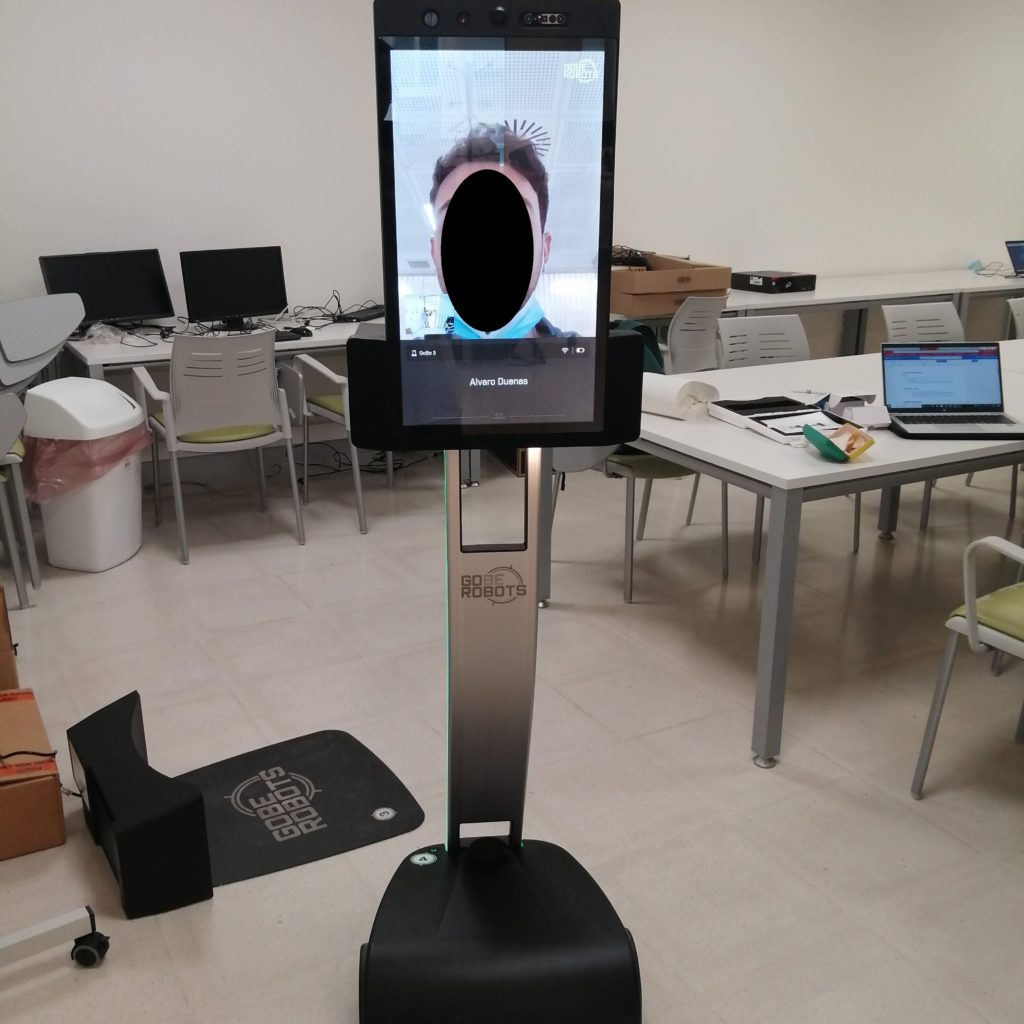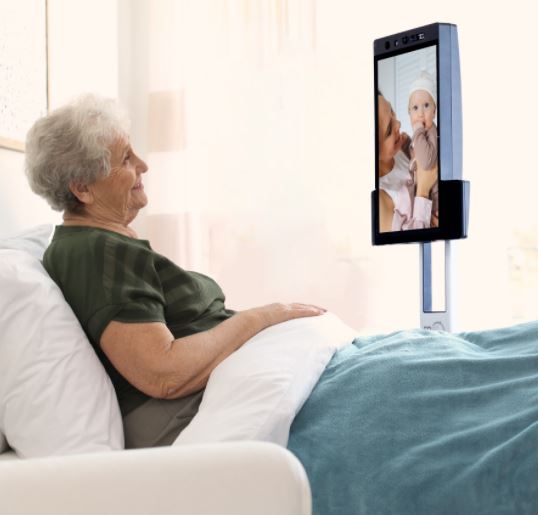Exploring about meaningful work & mobile telepresence robots in healthcare
The data collection for my first research project about robotics and meaningful work continued in Seville. Collecting data means gathering information, in my case, by conducting interviews, observing in a real setting, and reading archival data. I started at a nursing home in Málaga, Spain where I had the chance to interview the staff and observe the dynamics of the nursing home called Vitalia Teatinos, where there are a couple of mobile telepresence robots (MTRs) being tested (GoBe and CLARC). You can read more about this stage of the data collection here. After the nursing home, the second and third settings I visited were two different hospitals in Seville. Each hospital has a GoBe robot.

Testing GoBe at the hospital facilities. Picture was taken by the author.
As I mentioned in my last blog post, I was able to collect data there thanks to Blue Ocean Robotics, EINST4INE’s industry partner, and thanks to the University of Málaga and the Andalusian Health Service, who are working together on a project called SUSTAIN. In this project, they are testing GoBe, a mobile telepresence robot with video calling features to facilitate doctor-patient and patient-family members interactions. The main objective of SUSTAIN project is to test these robots in healthcare settings to understand how safe and effective they can be, and also to evaluate the medical, patient, resident, and family satisfaction of such interactions.

Source: GoBe Robots
In my opinion, MTRs can be a great tool to support physical presence and enable telemedicine in ways that a tablet and a mobile phone cannot provide. I think that the embodiment of the robot can provoke different sensations compared to other devices, for example, GoBe’s height resembles a human height and that may provoke a different sensation than when video calling through a mobile phone. Also, the big screen allows you to have a clear view of the face, which is sometimes hard when you have a video call via mobile phone, and you cannot show your complete face because of the camera’s limited reach.
This is only my point of view from what I have seen, but some studies have explored the use of MTRs for telemedicine and found that it can be effective indeed but also involves implementation challenges (Beane & Orlikowski, 2015; Laigaard et al., 2022). Implementing robots at the workplace implies changing organizational dynamics, work practices, and occupations challenging socio-psychological factors. This is where my research inquiry starts: robots’ impact on healthcare workers’ social dynamics has received little attention, for example, the effects on meaningful work.
Meaningful work allows employees to fulfill the purpose of their life via daily work practices and that is linked to human well-being. In healthcare and caring practices, some studies have found that the personnel finds meaningful work within social relationships (Pavlish & Hunt, 2012; Pavlish et al., 2019). For example, building relationships with patients and family members and also when they are explicitly acknowledged for their work.
Therefore, my research project will explore meaningful work perceptions of healthcare staff when interactions are afforded by MTRs. Accessing empirical data and interviewing participants at their workplaces was a great opportunity. The different settings allowed me to obtain insights into the particular perceptions of a clinician that is working at a hospital compared to one that is working at a nursing home. I was also able to interview some independent clinicians that work at private clinics or at the patients’ homes, which made it even more interesting. It was very intriguing to see the different perspectives that each of them had depending on their occupation. The participants had different occupations such as physiotherapists and psychologists and it helped me to understand what their points of view are about robotics and meaningful work, daily practices, and what they think about using MTRs in their workplace.
Now it is time to analyze the data and write up!
References:
Beane, M., & Orlikowski, W. J. (2015). What Difference Does a Robot Make? The Material Enactment of Distributed Coordination. Organization Science, 26(6), 1553–1573. https://doi.org/10.1287/orsc.2015.1004
Laigaard, J., Fredskild, T. U., & Fojecki, G. L. (2022). Telepresence Robots at the Urology and Emergency Department: A Pilot Study Assessing Patients’ and Healthcare Workers’ Satisfaction. International Journal of Telemedicine and Applications, 2022, 1–6. https://doi.org/10.1155/2022/8787882
Pavlish, C., & Hunt, R. (2012). An Exploratory Study About Meaningful Work in Acute Care Nursing: An Exploratory Study About Meaningful Work in Acute Care Nursing. Nursing Forum, 47(2), 113–122. https://doi.org/10.1111/j.1744-6198.2012.00261.x
Pavlish, C. L., Hunt, R. J., Sato, H.-W., & Brown-Saltzman, K. (2019). Finding Meaning in the Work of Caring. In R. Yeoman, C. Bailey, A. Madden, & M. Thompson (Eds.), The Oxford Handbook of Meaningful Work (pp. 236–256). Oxford University Press. https://doi.org/10.1093/oxfordhb/9780198788232.013.14


Add a Comment